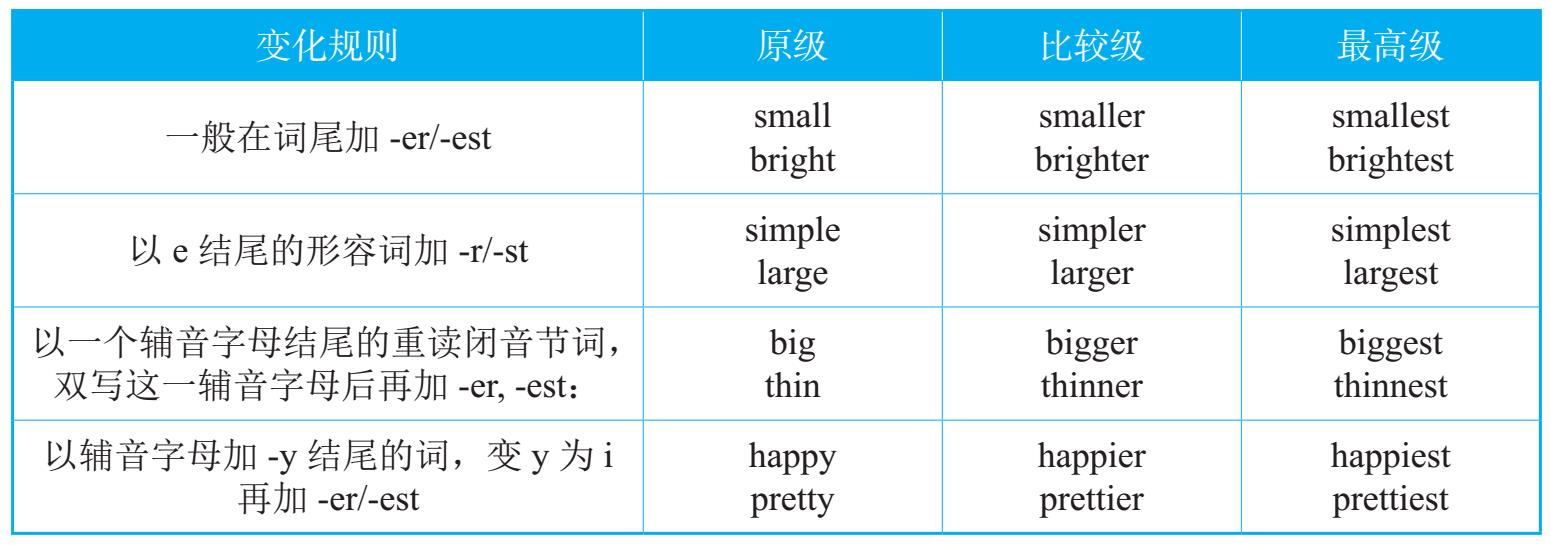




1 形容词
2 副词
表示人或事物的属性。特征或状态的词叫形容词。形容词修饰名词,其用法就是为名词提供更多的信息。
① 简单形容词:kind 善良的,cleaver 聪明的,broad 宽广的, interesting 有趣的等;
简单形容词具有独特的后缀形式。
例 a. 名词/动词+ful:beautiful 美丽的;wonderful美妙的;
b. 名词/动词+less:worthless 无价值的;careless 粗心的;
c. 名词+ly:friendly 友好的,lovely 可爱的;
d. 名词+ous:anxious 焦虑的;poisonous 有毒的;
e. 以-ly 结尾的貌似副词的形容词还包括:silly 愚蠢的,糊涂的;elderly 年长的,过时的等。
② 复合形容词:复合形容词是由两个或两个以上的单词通过连字符的连接而合成的、起到形容词作用的词。
a. 数词+名词
a ten-speed bicycle 一辆十速自行车
800-metre race 800米赛跑
b. 数词+名词ed
three-legged cat 三脚猫
one-eyed dragon 独眼龙
c. 数词+名词+形容词
a four-year-old boy 一名四岁的男孩
an 1000-metre-long bridge 一座一千米长的桥d. 名词+形容词
a world-famous scientist 一名世界著名的科学家
duty-free product 免税产品
e. 名词+现在分词
peace-loving people 热爱和平的人们
French-speaking country 说法语的国家
f. 名词+过去分词
a man-made satellite 一颗人造卫星
a snow-covered mountain 一座被雪覆盖的山
g. 形容词+名词
long-distance bus 长途公共汽车
the Mid-autumn Festival 中秋节
h. 形容词+现在分词
an easy-going person 一个随和的人
a long-standing friendship 一段长久的友谊
i.形容词+过去分词
a new-found house 一座新近找到的房子
ready-made meals 现成的食物
j.形容词+名词ed
an absent-minded student 一个心不在焉的学生
a warm-hearted boy一个热心肠的男孩
k. 副词+现在分词
far-reaching reform 深远的改革
a hard-working worker 一名勤劳的工人l.副词+过去分词
a well-educated gentleman 一名受过良好教育的绅士
a newly-built bridge 一座刚建的大桥
注: 当复合形容词中含有可数名词时,这个名词只能用单数。例如:
100-metre 一百米;forty-year-old 四十岁
① 作主语
例 The poor stand up now. 穷人们站起来了。
Both old and young in the village came to the dinner. 村里的老老少少都来吃晚餐了。
② 作宾语
例 He admired the rich. 他羡慕有钱人。
We should care more about the poor. 我们应该多关心贫困的人。
③ 作定语
例 Miss Wu is a funny teacher. 吴女士是个有趣的老师。
I have something important to do. 我有一些重要的事情要做。
注: · 只能作定语的形容词:
main 主要的;elder 年长的;only 唯一的;middle 中间的
· 多个形容词作定语时的排列顺序:限定词(冠词、指示代词、形容词性物主代词、名词所有格)+数词+描绘性形容词(表示观点、品质、状态等的词)+表示特征的形容词(大小、长度、形状、新旧、年龄等)+表示颜色的形容词+表示类属的形容词(包括国籍)+表示材料质地的形容词+用途词+所修饰的名词,例如:
There are a few big round new black Britain wooden tables in the room.
这个房间里有几张新的产自英国的黑色大圆木桌。
I always remember the last few unforgettable sunny days on the beach.
我会一直记得在海滩上度过的最后这段令人难忘的、阳光明媚的日子。· 巧记:总限观,大形龄,色国材
④ 作表语
例 The performance was marvelous. 表演精彩极了。
It’s very cold today. 今天冷极了。
注: 有些形容词作表语时,通常不可以用“人”作主语,常见的有:
convenient/inconvenient 方便的/不便的;
possible/impossible 可能的/不可能的
necessary/unnecessary 必要的/不必要的;
probable/improbable可能的/不可能的
⑤ 作补足语
 宾语补足语:在复合宾语结构中,形容词作宾语补足语说明宾语的性质、状态或特征。
宾语补足语:在复合宾语结构中,形容词作宾语补足语说明宾语的性质、状态或特征。
例 The teacher kept us busy preparing our lessons. 老师让我们忙于准备功课。
He always makes us happy. 他总能让我们很高兴。
 主语补足语:在被动语态中,说明主语的性质、状态或特征。
主语补足语:在被动语态中,说明主语的性质、状态或特征。
例 The artist was born poor. 这位艺术家出身贫寒。
The bottle was found empty. 瓶子被发现是空的。
⑥ 作状语
形容词作状语表示伴随、原因、结果、让步等,一般不表示动作的方式。
例 He got home, cold and hungry. 他饥寒交迫地回到家。
Unable to answer the question, the boy said nothing. 由于无法回答这个问题,这个男孩儿一言不发。
① 形容词作定语时一般位于被修饰的名词之前。
例 My teacher is a kind person. 我的老师是一个善良的人。
That’s an impossible thing. 那是不可能的事情。
② 形容词后置的情况
a. 一些表语形容词作定语时必须置于名词后,如:alive, afraid, awake, alone,asleep, worth, aware, ashamed, alike等。
例 He is the most famous artist alive today. 他是目前在世的最著名的艺术家。
We saw nothing alive. 我们看到的是一片死气沉沉。
b. 当复合不定代词someone, somebody, something, anyone, anybody, anything,nobody, nothing, everyone, everybody, everything被形容词修饰时,形容词通常后置。
例 There is something wrong with my watch. 我的手表出毛病了。
Don’t do anything stupid. 不要做任何蠢事。
c.“形容词+介词+名词”或其他短语作定语时要后置。
例 a bag full of money 装满钱的袋子
a job suitable for me 一项适合我的工作
d. 两个意义相近或相反的形容词用both ... and, and, or, but或so连接在一起作定语时,形容词后置。
例 The students were required to see a movie both instructive and patriotic. 学生们被要求看一部既有教育意义又有爱国主义的电影。
All the people in this village, young or old, are fond of music. 这个村里的人,不论年轻还是年老的,都喜欢音乐。
e. 形容词else常置于不定代词或疑问代词之后作定语。
例 Does anyone else have any questions about learning English? 还有其他人有关于英语学习的问题吗?
Who else will go with us? 还有谁会和我们一起去?
f. 当long, wide, high, deep, thick, away, old等词与数量词短语连用时,形容词要后置。
例 The street is 10 meters wide. 这条街有十米宽。
At that time he was only a boy five years old. 那时他只是一个5岁的小男孩。
注: 有些形容词既可以作前置定语,也可以作后置定语,但意义不同,常见的有:present现在的/在场的,responsible可依赖的/应负责任的,proper适当的/正式的,absent心不在焉的/缺席的。例如:
the absent students 心不在焉的学生
the students absent 缺席的学生
the responsible government 可依赖的政府
the government responsible 应负责的政府
英语中的形容词常有三种形式来表达事物的等级差别,即原级、比较级和最高级。原级即形容词的原形,用来说明人或事物的特征,比较级用在两个人或物之间的比较,最高级用来比较三个或三个以上的人或物。
① 单音节和少数多音节的形容词的比较级和最高级变化规则:

② 多音节形容词的比较级和最高级的变化规则:一般是在原级前加more构成比较级,在原级前加most构成最高级。
例 beautiful — more beautiful — the most beautiful
enthusiastic — more enthusiastic — most enthusiastic
③ 某些单音节形容词,加more, most 构成比较级和最高级。
例 glad — more glad — most glad
tired — more tired — most tired
④ 词尾以-er, -le和-ow结尾的形容词有两种构成方式。
clever—cleverer/more clever—cleverest/most clever
gentle—gentler/more gentle—gentlest/most gentle
narrow—narrower/more narrow—narrowest/most narrow
⑤ 不规则形容词的比较级和最高级。
good / well—better—best
bad / ill/evil—worse—worst
little—less/lesser—least
old—older/elder—oldest/eldest
many/much—more—most
far—farther/further—farthest/furthest
① 同级比较级的用法:as+形容词原级+as(其中第一个as是副词,修饰形容词;第二个as是连词,连接比较对象)。as+形容词原级+as用于肯定句中,表示相比较的两者情况一样;not so/as+形容词原级+as用于否定句中,表示在相比较的两者中前者不如后者。
例 She is as tall as Tom. 她和汤姆一样高。
The woman looks as young as she was ten years ago. 这位女士看上去和十年前一样年轻。
Your handwriting is not as/so beautiful as mine. 你的字迹不如我的好看。
She cannot run so/as fast as you. 她没你跑得快。
注: 如果第一个as/so后的形容词作定语修饰单数可数名词,冠词应置于形容词之后,可数名词之前。例如:
The girl has as sweet a voice as her mother. 这个女孩儿的声音像她妈妈的一样甜美。
Miss Judy isn’t as/so strict a teacher as Mr. Brown. 朱迪小姐不像布朗先生那么严厉。
(同级比较还可以用the same ... as ... ,such ... as ... 结构引导)
② 比较级的单独运用
比较级有时可单独使用,其比较对象暗含在句中。
例 Are you feeling better today? 你今天感觉好点了吗?
Be more cautious next time. 下次小心点儿。
③ “比较级+than”表示相比较的两者程度不同。
例 She made fewer mistakes than you (did). 她比你犯的错少。
The room is bigger than that one. 这个房间比那个大。
注: 在比较级前面可以有一个表示程度的状语来修饰,如:a great deal of, a lot, a little (bit),even, hardly, any, many, much, no, rather, somewhat, three (four, five ... ) times,by far ... ;例如:
This question is a little more difficult than that one. 这个问题比那个问题稍难一点。Your watch is far better than mine. 你的手表比我的好多了。
④ “比较级+and+比较级”表示事物本身的程度逐渐增加,意为“越来越……”。
例 The weather is getting colder and colder. 天气变得越来越冷了。
Our hometown is becoming more and more beautiful. 我们的家乡变得越来越美了。
⑤ “the+比较级……,the+比较级……”表示两者程度平行增长,意为“越……(就)越……”。
例 The more I read the book,the more I liked it. 这本书我越看越喜欢。
The higher the ground is, the thinner air becomes. 离地面越高,空气就越稀薄。
⑥ “not+比较级+than”与“no+比较级+than”
“not+比较级+than”表示“前者不比后者更……”,“no+比较级+than”表示“前者和后者一样不……”。
例 My English is not better than yours. 我的英语不比你的好。
My English is no better than yours. 我的英语和你的一样差。
⑦ “the+比较级+of the two+名词”表示“两者中较……的那个”。
例 Do you know the taller of the two boys? 你认识这两个男孩中较高的那一个吗?
Mike is the cleverer of the two students. 麦克是这两个学生中较聪明的那个。
⑧ 其他形式的比较级
在senior, junior, superior, inferior和prior等形容词后需要加to,不用than。
例 I am five years senior to Jim. 我比吉姆大五岁。
Jim is five years junior to me. 吉姆比我小五岁。
This computer is superior to the one you bought. 这台电脑比你买的那台好。
This computer is inferior to that one. 这台电脑比那台差。
① 最高级表示在三者或三者以上中程度最高,其形式为“the+形容词最高级(+名词)+表示范围的短语或从句”。
例 This is the oldest theater in New York. 这是纽约最古老的剧院。
This necklace is the least expensive. 这条项链是最便宜的。
注: 介词in和of 引导的短语说明比较的范围,如果在一定的地域空间内要用in, 在同一类事物范围内进行比较用of。例如:
Shanghai is the biggest city in China. 上海是中国最大的城市。
Shanghai is the biggest city of all the cities in China. 上海是中国所有城市中最大的。
最高级的修饰语:much, (by) far, nearly, almost以及序数词等。例如:
The Yangtze River is the third longest river in the world. 长江是全球第三长河。
Of all the students, Jack is almost the best in English. 在所有学生中,杰克的英语几乎是最好的。
② 比较级表示最高级含义的几种形式。
a. 比较级+than any other+单数名词
例 She works harder than any other student in her class. 她在班里学习最用功。
China is larger than any other country in Asia. 中国是亚洲最大的国家。
b. 比较级+than the other+复数名词
例 She goes to school earlier than the other girls. 她比其他女孩早上学。
Tom is taller than the other boys in his class. 汤姆在班里的男孩子中个子最高。
c. 比较级+than+any of the other+复数名词
例 Russia is larger than any of the other countries in Europe. 俄罗斯是欧洲最大的国家。
Shanghai is larger than any of the other cities in China. 上海是中国最大的城市。
d. 比较级+than+anything/anyone else
例 Tom did more work than anyone else. 汤姆干的活最多。
He cared more for money than for anything else. 他最喜欢钱。
e. 否定句中使用比较级
例 She likes nothing better than swimming. 她最喜欢游泳。
Nobody can do the work better than he did. 这项工作他做得最出色。
③ 最高级不表示“最……”的用法
形容词最高级前如果没有定冠词the,就没有比较的意思,只是用来加强语气,有“很,非常”之意。
例 Linda is a kindest girl. 琳达是一个非常善良的姑娘。
This is a most interesting book. 这是一本非常有趣的书。
注: 形容词最高级前有物主代词、名词所有格时不带the;两个或多个形容词最高级并列使用时从第二个起不带the;形容词最高级在句中作宾语补足语时常不带the。Jim is the old man’s eldest son. 吉姆是这位老人的大儿子。He is the youngest and tallest boy in our class. 他是我们班年龄最小、个子最高的男孩。
 2 副词
2 副词
副词是指在句子中表示行为或状态特征的词,用来修饰动词、形容词、其他副词、介词短语、非谓语动词乃至整个句子,表示时间、地点、程度、方式等概念。
根据其意义和语法功能,副词可分为时间副词、频度副词、地点副词、程度副词、方式副词、疑问副词、关系副词和连接副词。
① 时间副词指表示发生时间的副词:now 现在,then 那时,just now 刚才,later 之后,right then 就在那时,right away 立刻等。
例 How are you feeling today? 你今天感觉怎么样?
I have heard from her recently. 我最近收到了她的来信。
② 频度副词指表示频繁程度的副词:always 总是,constantly 频繁地,continually 持续不断地,ever 曾经,frequently 频繁地,never 从不等。
例 She was always late for rehearsals. 她排练时总是迟到。
He never reads such books. 他从不看那样的书。
③ 地点副词指表示地点和位置的副词:abroad 在国外,ahead 在前面,away 在远处,back 在后面,down 在下边,downstairs 在楼下,downtown 在市区,eastward 向东,anywhere 任何地方等。
例 He is upstairs talking with my friends. 他正在楼上和我朋友们谈话。
Don’t stand outside. It’s too cold. 不要站在外面,太冷了。
④ 程度副词指描述动作、行为或状态程度的副词:absolutely 完全地,almost几乎,amazingly 令人惊异地,enormously 非常地,enough 充足地,entirely完全地,extremely 极端地,fairly 相当,fully 完全地,等。
例 This mission is extremely difficult. 这项任务极其艰难。
You’re entirely wrong. 你完全错了。
⑤ 方式副词指描述事情或情况的进行、存在方式,情绪、动作发生的情况或其细节的副词(方式副词主要用来回答how的提问):angrily 生气地,anxiously 焦急地,badly 糟糕地,calmly 冷静地,carefully 仔细地,carelessly 粗心地,clearly 清晰地,closely 紧密地等。
例 She read the letter slowly. 她从容不迫地看了那封信。
He carelessly left the garage door unlocked. 他太粗心大意,竟然没锁车库的门。
⑥ 疑问副词用来引导特殊疑问句,表示时间、地点、方式、原因等:where 在哪里,when 在什么时候,why 为什么,how 如何,whenever 究竟什么时候,wherever 究竟在哪里等。
例 Where will you go to spend your summer holiday? 你要去哪里过暑假?
How often do you see a movie ? 你多久看一次电影?
⑦ 关系副词主要用来引导定语从句:where ... 的地方,when ... 的时候,why ... 的原因等。
例 I still remember the day when I first came to Beijing. 我依然记得第一次到北京的那天。
Can you tell me the reason why you are so happy? 能不能告诉我你这么高兴的原因?
⑧ 连接副词分为两类,一类用于连接句子或从句,常见的有therefore 因此(表结果),besides 况且(表补充),however 不管怎样(表转折),otherwise否则(表条件);另一类用于引导从句或不定式,主要有when, why, where,how等。
例 I don’t like it, besides, it’s too expensive. 我不喜欢它,而且它太贵了。
I don’t know how I can find her. 我不知道如何找到她。
① 时间副词和地点副词一般放在句末,有时也可放于句首。
例 Yesterday he went to the airport to see his teacher off. 昨天他去机场送他老师了。He went to Paris recently. 他最近去了巴黎。
注: 如果这两种副词同时出现在句中,则把地点副词放在时间副词前面。例如:
He has gone nowhere recently, for he has a dozen irons in the fire. 他最近哪里都没去,因为他实在太忙了。
② 表示不确定的时间副词,如always, seldom, often, never, rarely等通常放在行为动词前,情态动词、助动词或be动词之后。
例 She is always the first to come to class. 她总是第一个到班里。
The old man seldom goes out. 这位老者很少外出。
③ 修饰形容词和副词时,程度副词除enough外应放在形容词和副词前面;修饰动词时,常常放于第一个助动词后,实义动词前。
例 The boy acted rather strangely. 这个男孩行为举止相当古怪。
I greatly enjoy talking with you. 我很喜欢和你聊天。
④ 方式副词一般放在动词(+定语)的后面,在表示特别强调时,偶尔也可放在实义动词的前面,第一个助动词的后面。
例 Tom wrote carefully some letters to his teachers. 汤姆认真给他的老师们写信。
He quickly announced that he didn’t know anything about the matter before hand. 他迅速宣布他事先毫不知情。
⑤ 频度副词在句中的位置比较灵活,可以置于谓语动词前,也可以置于第一个助动词后,还可以置于句首。
例 I have seldom seen such large eggs. 我很少见到这么大的鸡蛋。
Usually he goes to America in August. 通常他8月份会去趟美国。
⑥ 副词修饰名词时,一般放在该名词之后。
例 The young lady there is Linda’s sister. 那边的年轻女士是琳达的姐姐。
The villagers there are busy getting in wheat. 村民们正在收割小麦。
⑦ 副词修饰全句时,一般放在句首。
例 Luckily, she was not hurt in the accident. 幸运的是,她在这次事故中没有受伤。
Truly he is an honest man. 真的,他是个诚实的人。
⑧ 有些副词像fortunately, luckily, surprisingly, honestly, actually, unfortunately等修饰整个句子时,表示说话者的态度,或者起着连接上下文的作用,常可以和句型It + be + adj. + that ... 进行转换。
例 两个中年男人掉入死海。不幸的是,他们两人都不会游泳。
Two middle-aged men fell into dead sea. Unfortunately, neither of them could swim.
→ It was unfortunate that neither of them could swim.
令人感到惊讶的是全班没有一个同学能解决这个问题。
Surprisingly, no one in the classroom can work out the problem.
→ It is surprising that no one in the classroom can work out the problem.
副词和形容词一样,也有比较级和最高级形式,单音节词和少数双音节词可以通过在词尾加-er和-est的方式构成比较级和最高级;双音节词和多音节词大多以加more和most的方式构成比较级和最高级。
例 fast —faster— fastest
late — later —latest
early—earlier—earliest
quickly—more quickly—most quickly
注: 副词的比较级和最高级形式也有不规则变化,例如:
well —better—best
badly—worse —worst
much—more—most
little—less—least
① 比较级的单独运用。
例 Would you please speak more slowly? 请讲慢一点,好吗?
Can’t you live here a little longer? 你不能在这里再多住一段时间吗?
② 比较级+than,这种句式可以表达一方超过另一方的情况,也可以表达一方不如另一方的情况。
例 The car’s running less smoothly than it used to. 这辆车跑得没有过去平稳了。
Tom drove much more carefully than I. 汤姆开车比我小心得多。
③ “no+比较级+than ... ”表示“都不”,是对两者的共同否定,且侧重前者。
“not+比较级+than ... ”表示“不比……更”,表示相比较的两者情况相当。
例 She speaks Chinese no more fluently than her brother. 她汉语说得和她弟弟一样都不流畅。
I run not faster than you. 我不比你跑得快。
④ 比较级+and+比较级,这种句式用于表示自身情况的逐渐增长,意为“越来越……”。
例 The fire spread further and further with the wind blowing more and more strongly. 随着风越刮越大,大火蔓延得越来越远。
⑤ the + 比较级…,the + 比较级…,这种句式用来表示一方的程度随着另一方的程度平行增长,意为“越……(就)越……”。
例 The harder you work, the better you’ll learn. 你越努力,学得越好。
The more you talk to the children, the less they will listen. 你对孩子们谈得越多,他们听进去的就越少。
⑥ 最高级的用法:最高级主要用“the + 副词最高级(+表示范围的短语或从句)”
结构表示。最高级前的定冠词the 可省略。
例 Tom runs (the) fastest in his class. 汤姆是班里跑得最快的一个。
Brandon jumps (the) highest but runs (the) most slowly of the three boys. 这三个男孩中,布兰登跳得最高,但跑得最慢。
在英语中某些词有两种或两种以上的形容词形式,它们词形相近,但词义不同,容易用错。
historic 历史上著名的
historical 历史上的
considerable 相当多(大)的
considerate 体谅的,体贴的,周到的
sensible 实用的, 明知的
sensitive 敏感的
continual 连续的,断断续续的
continuous 连续不断的
intense 强烈的,剧烈的,高度的
intensive 精深的,集中的
respectable 值得尊敬的
respectful 尊敬人的
respective 分别的,各自的
imaginable 可想象的
imaginary 想象中的
imaginative 有想象力的